Mid-early table potato variety "Romano" from Dutch breeders
Romano potatoes are a medium-early table variety of Dutch breeding. The culture is suitable for growing on an industrial scale and for personal consumption. The tubers are distinguished by their evenness, pink hue of the peel, excellent taste and are not prone to germination.
The plant bears fruit even in drought conditions, subject to moderate watering. In the article, we will talk about the traditional and Dutch methods of cultivating potatoes, measures to prevent common scab and how to get rid of the Colorado potato beetle and wireworm, and share the reviews of summer residents.
The content of the article
Characteristics and history of the creation of the variety
The breeders of the Dutch company AGRICO U.A. were engaged in the development of the Romano variety.
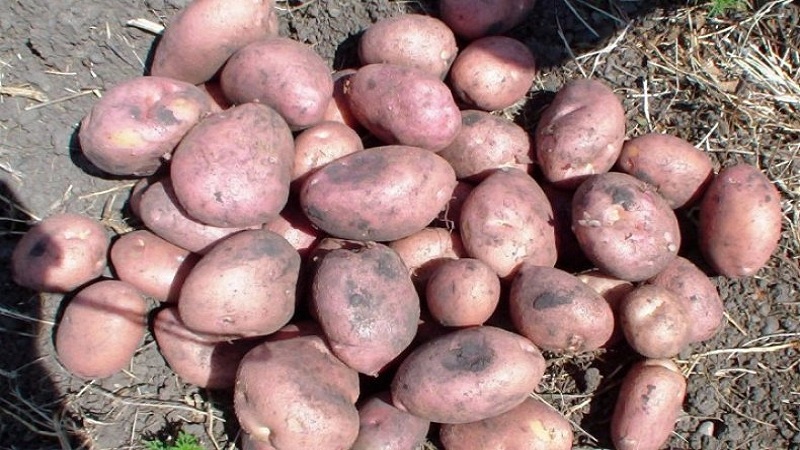
The description of the variety is presented in the table:
| Indicators | Characteristic |
| Ripening period | 65-80 days |
| Bush | Tall, erect, compact |
| The number of tubers in the bush | 8-13 pcs. |
| Weight | 70-80 g |
| The form | Short oval |
| Coloration
|
The pulp is light cream, the skin is pink, with small eyes of medium depth |
| Leaves
|
Medium size, dark green, slightly wavy around the edges |
| Corolla color | Red-violet |
| Starch content | 10-13% |
| Taste | A great |
| Cooking class / group | Type B, slightly friable tubers |
| Yield | 110–347 c / ha |
| Marketability | 90–94% |
| Keeping quality | 98% |
| Appointment | Dining room |
| Sustainability | Immunity to cancer, medium resistance to mosaic viruses, late blight, rhizoctonia, leaf-rolling virus, susceptibility to common scab. |
| Transportability | High |
In the photo - Romano potato variety.
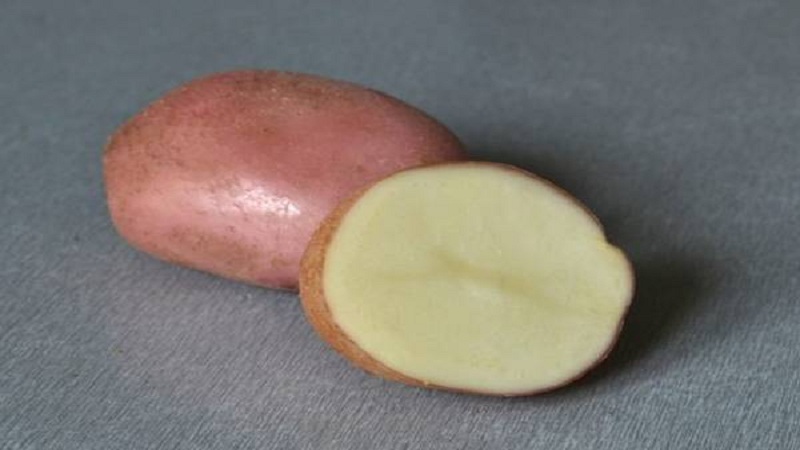
Agricultural technology varieties
Growing Romano potatoes is a task that can be done even by a novice gardener. The culture needs moderate watering, loosening the soil, hilling, weeding weeds and making additional fertilizing... The variety is grown according to standard and Dutch technologies. At the same time, the yield remains at a high level.
Timing, scheme and landing rules
Romano potatoes are planted in mid-April in the southern regions, and at the end of May - in the middle lane. The soil should warm up to + 15-20 ° С.
The crop grows on any type of soil... Before planting, the site is dug up and fertilized with manure. If the groundwater is close to the surface, the beds are formed at a level of 40 cm.
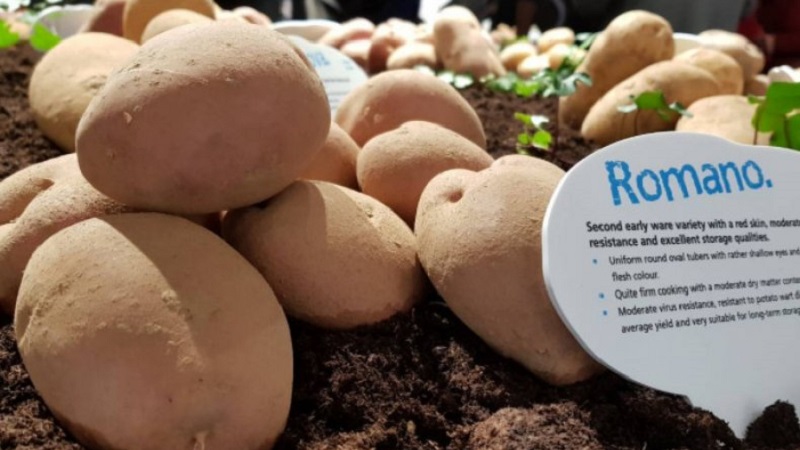
Tubers for planting are selected in the fall... In the spring, they are re-sorted and laid out for germination in a bright room on a flat surface in one layer. The optimum air temperature is + 14 ° С.
For disinfection, the tubers are soaked in a solution with the composition:
- 40 g of urea;
- 60 superphosphate;
- 10 g boric acid;
- 5 g of copper sulfate;
- 1 g of potassium permanganate;
- 10 liters of hot water (+ 80 ° C).
The components are mixed in an enamel container and the tubers are soaked in liquid for 15-20 minutes. Then they are dried.
Before planting, the material is treated with stimulants. "Poteytin", "Epin", "Fumar".
Reference. Unsprouted tubers sprout in three weeks. Processed planting material germinates 1-1.5 weeks earlier.
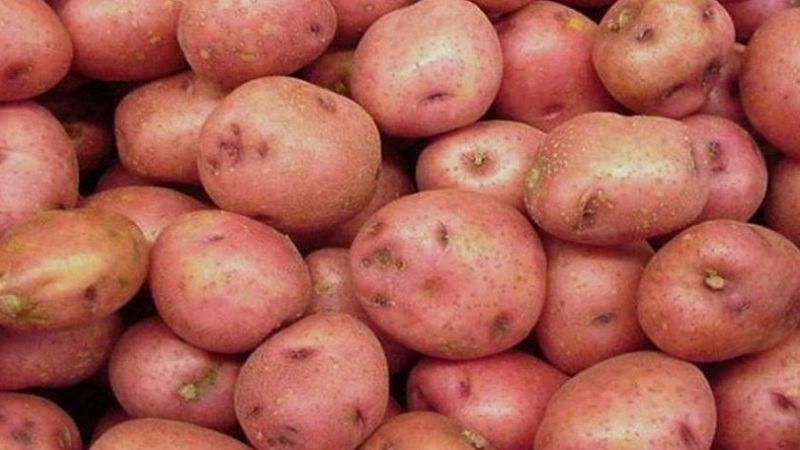
Location on form pits 20 cm deep at a distance of 30-35 cm... The gap between the rows is 60-70 cm. 200 g of wood ash are poured into the holes. Small tubers are buried in the ground in 2-3 pieces, large ones are cut in half and sprinkled with ash.
Other varieties of potatoes:
Unique looking and great tasting Picasso potatoes
Care
Planting care rules:
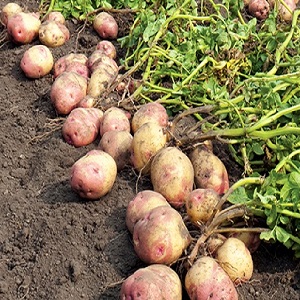 Regular watering once a week in temperate regions, 2-3 times in the southern regions.
Regular watering once a week in temperate regions, 2-3 times in the southern regions.- Organization of a drip system at the site to control the moisture level.
- Loosening the soil after each watering to prevent crust formation.
- Regular weeding of weeds.
- Hilling is carried out two weeks after planting and again after flowering. Thanks to this, the soil is saturated with air, more tubers are formed.
Potatoes fed twice with root fertilizers:
- before planting, a solution of chicken manure (1 tbsp. l. dry chicken manure per 10 l of water) or mullein (500 g of mullein, 20 g of urea per 10 l of warm water) is introduced;
- after flowering, fertilize with mineral compounds (15 g of potassium sulfate, 15 g of superphosphate per 10 l of water).
For better absorption of minerals use foliar feeding:
- Dissolve 2 g of sodium humate in 10 l of water;
- Dissolve 200 g of urea and 10 g of boric acid in 10 liters of water;
- Dissolve 10 g of granulated yeast and 50 g of sugar in 10 liters of water, leave for three hours and dilute with water in a ratio of 1: 5.
The nuances of growing and possible difficulties
When growing potatoes it is recommended to observe the crop rotation... Planting tubers in the same place from year to year leads to infection with viral and fungal infections. The best predecessors of potatoes are legumes, cabbage and cauliflower, pumpkin.
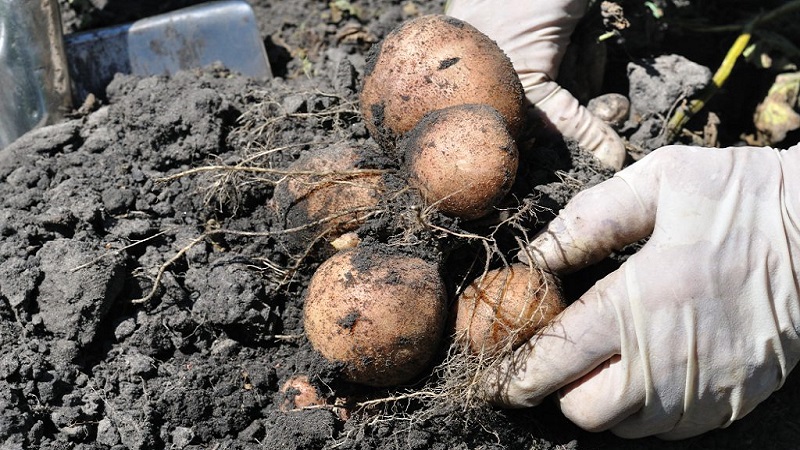
Summer residents practice another technology of growing potatoes Romano - Dutch... It provides for the complete abandonment of beds and holes in favor of long furrows in which prepared tubers are planted.
Reference. To test the soil for readiness for planting potatoes, take a handful of earth, squeeze it slightly and throw it back. If the lump has crumbled, then you can start working.
Method advantages:
- Tubers are embedded to a depth of 10-15 cm for unhindered air penetration to the root system.
- Moisture does not accumulate in the soil and the root system does not rot.
- The bushes receive enough sunlight, which positively affects the yield.
- 1.5-2 kg of selected potatoes are harvested from each bush.
Such the result can be achieved only if the landing rules are followed:
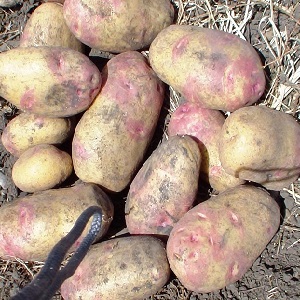 Tubers are laid in the holes immediately after soil preparation. The delay causes the earth to dry out.
Tubers are laid in the holes immediately after soil preparation. The delay causes the earth to dry out.- For 1 sq. m have 6-8 tubers, sprouts up.
- The wells are filled with fertilizers so that the tubers are located under them. Humus, manure, chicken droppings, wood ash or crushed eggshells are used as top dressing.
- Row spacing - 70-80 cm, distance between bushes - 25-35 cm.
- The first sprouts are covered with earth, forming ridges with a height of 8-12 cm. A month later, the procedure is repeated, shoveling the earth to a height of 25-30 cm. In the future, hilling and weeding are not carried out. Against weeds, use herbicides "Titus", "Centurion", "Lazurit".
- The plot is watered three times: before flowering, 10 days after the appearance of flowers and at the end of flowering. The installation of a drip irrigation system will help to facilitate the care of the bushes.
Diseases and pests
The culture has a strong immunity to cancer, is characterized by medium resistance to mosaic virus and leaf twisting, late blight, and rhizoctonia. Potatoes susceptible to common scab.
Scab spores develop at an air temperature of + 30-35 ° С, soil - + 25-27 ° С. Favorable habitat - alkaline soil with moisture deficit. Spores form on unharvested plant debris and pass to tubers through the damaged skin. The pathogen is distinguished by enviable vitality and can "sit" in the ground for years.
Reference. Scab spores infect varieties of potatoes with red or pink skin.
Control methods:
- planting healthy tubers without signs of infection;
- disinfection of planting material in copper sulphate, potassium permanganate, "Fitosporin";
- timely watering of the beds;
- top dressing of the soil with copper, manganese and boron;
- compliance with crop rotation;
- acidification of alkaline soils with ammonium sulfate (2 tablespoons per 10 liters);
- sowing green manure plants after harvesting (wheat, rye, lupine, rapeseed, peas, mustard);
- treatment of bushes with "Zircon" to suppress the growth of scab spores;
- spraying plantings with fungicides: "Maxim", "Albit", "Kolfugo", "Acrobat MC", "Mankotseb", "Ordan".
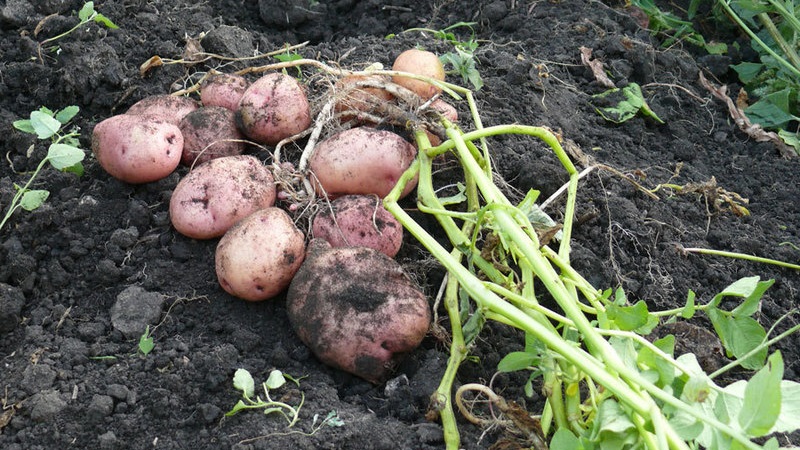
To destroy the Colorado potato beetle one treatment with fungicides is enough: "Prestige", "Tabu", "Aktara", "Corado", "Killer", "Fitoverm", "Colorado potato beetle NO!"
Traditional methods:
- The bushes are powdered with corn flour. After entering the stomach of insects, small particles swell, causing their death. The procedure is carried out in the morning, showering leaves damp with dew for better adhesion.
- 1 kg of leaves or green fruits of a walnut pour 10 liters of hot water, leave for a week, strain before use.
- Crumble 100 g of dry roots of elecampane and pour 5 liters of hot water, leave for 2-3 hours and process the bushes.
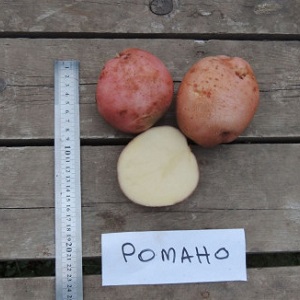 Chemicals will help fight wireworm: "Decis", "Actellik", "Barguzin".
Chemicals will help fight wireworm: "Decis", "Actellik", "Barguzin".
Folk remedies:
- processing of beds with ground eggshell;
- Pour 500 g of fresh nettle with 10 liters of hot water, insist and pour into the holes before planting, then process the beds three times during the week;
- sprinkle the area with ammonium nitrate (30 g per 1 sq. m).
Read also:
Collection, storage and use of the crop
Experienced farmers advise to cut the tops 6-7 days before harvesting... Digging should be carried out in dry sunny weather. Sort the tubers and dry in the sun for 2-3 days. A feature of the Romano variety is the slowed development of tubers. Therefore, when planting in the second decade of May, digging is carried out in mid-August.
The harvest is stored all winter until the next season in a cool place... The tubers are put in boxes or bags. A layer of beets is spread on top, which absorbs excess moisture, preventing rotting of the tubers.
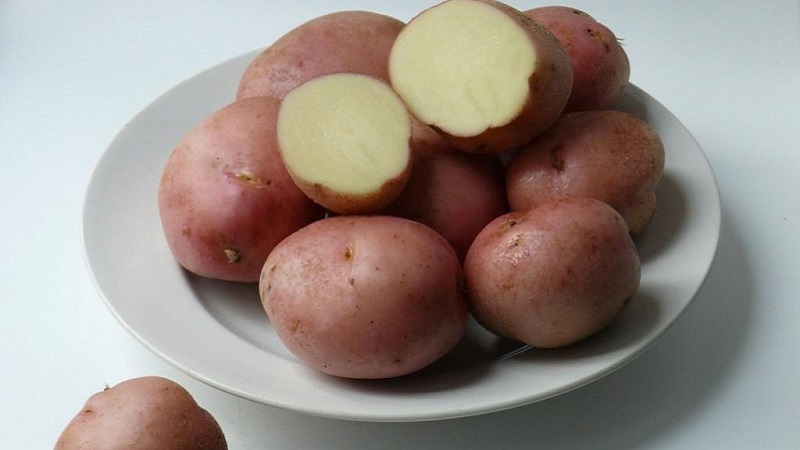
If there is no cellar, but you need to stock up on potatoes for the winter, a balcony or loggia is suitable for storage. The tubers are folded into homemade boxes made of polystyrene foam or boards and placed on a raised platform so that the bottom does not touch the floor and the fruits do not freeze. Old blankets, corrugated cardboard, foil material are used as insulation.
There are balcony cellars on sale that resemble a large backpack. Their volume is designed to store 1-3 bags of potatoes at air temperatures down to -40 ° C. The cellars are powered from the mains, consuming 120-240 watts.
Romano potatoes are suitable for boiling, stewing, baking, frying... The pulp does not boil, retaining its shape. Deep-frying creates a crispy golden crust.
Advantages and disadvantages
Advantages:
- high productivity;
- excellent taste;
- keeping quality;
- high level of transportability;
- unpretentious care;
- drought resistance;
- quick adaptation to climate and soil type;
- resistance to disease.
Disadvantage - low resistance to frost.
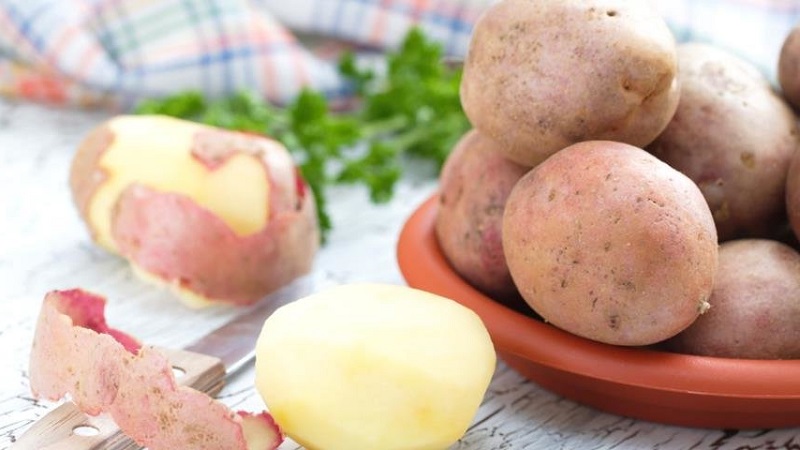
Growing regions
Potatoes have been approved for cultivation in Central, Volgo-Vyatka, Central Black Earth, Ural, Far Eastern regions. The crop is suitable for cultivation in dry areas, provided there is sufficient watering.
Reviews
The culture was highly appreciated by gardeners and consumers due to the excellent taste of fruits, retention of shape during cooking, strong immunity, high productivity.
Valentina, Pavlovsk: “Romano planted potatoes last year to replace the previous variety. I noticed that the stems and leaves of the plant are tougher, and the larvae of the Colorado potato beetle cannot gnaw them. Single individuals were collected by hand, I didn't even have to spray. Potatoes have a pink skin and slightly yellowish flesh, they are stored for a long time in the cellar ".
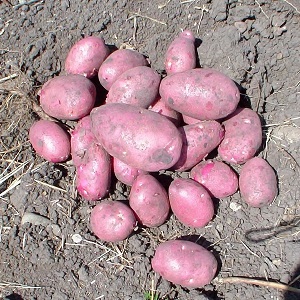 Daria, Moscow: “The year before last, we were left without potatoes for the winter. One little thing has grown.On the advice of neighbors, we bought Romano seed potatoes. There was so much harvest that they did not know what to do with, some of them were sold. They carried out one treatment from Colorado, twice harrowed and fed with chicken manure before flowering and minerals after. The tubers are perfectly preserved in the basement and do not grow ".
Daria, Moscow: “The year before last, we were left without potatoes for the winter. One little thing has grown.On the advice of neighbors, we bought Romano seed potatoes. There was so much harvest that they did not know what to do with, some of them were sold. They carried out one treatment from Colorado, twice harrowed and fed with chicken manure before flowering and minerals after. The tubers are perfectly preserved in the basement and do not grow ".
Oleg, Stary Oskol: “I grow several varieties of potatoes in the village, but Romano is one of my favorites. The fruits have excellent taste, the pulp retains its structure during cooking and roasting. I collect up to 1 kg of potatoes from one bush. There were no small tubers in all four years. When planting, I treat the seeds with copper sulfate to prevent scab. I fight the Colorado potato beetle with the help of the Killer drug. I store in the cellar in boxes until summer ".
Conclusion
Romano potatoes are popular with summer residents and large farmers. Consumers choose this variety due to its pleasant rich taste, keeping quality and the ability to prepare a variety of dishes. The dense pink peel withstands mechanical damage, allowing the product to be transported over long distances.
The culture is resistant to many diseases, but it is susceptible to infection with common scab spores. Preventive treatment of tubers before planting, weeding of weeds, sufficient watering, observance of crop rotation prevent the development of the disease. The Colorado potato beetle rarely infects bushes due to the stiffness of the stems and leaves, and eggshells, ammonium nitrate and nettle infusion will help get rid of the wireworm.